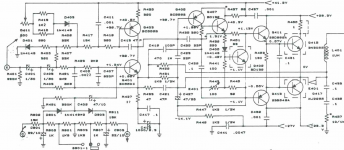Hello, this is my first project since years. I am trying to repair a NAD 7020e receiver and need some help. The right channel of the amplifier is working well, the left channel measured -14V DC at the speaker output.
Q413 was BC shorted and no connection between B/C and the emitter. Resistors R437 and R451 were burned due to this. Also, C415 was leaking. I replaced Q413, C415, C427 and the burned resistors.
After replacing the broken parts, the left channel was working but only at a low volume. After increasing the volume, Q413 became really hot, shortened again between BC and the resistors started smoking. The left channel measures -14V DC again.
I replaced the burnt parts and the amplifier is working again at a low volume. I measured all BE voltages, they are around 0.6V. Also, all the voltage indicated in the schematics are ok. Any help is appreciated!
Q413 was BC shorted and no connection between B/C and the emitter. Resistors R437 and R451 were burned due to this. Also, C415 was leaking. I replaced Q413, C415, C427 and the burned resistors.
After replacing the broken parts, the left channel was working but only at a low volume. After increasing the volume, Q413 became really hot, shortened again between BC and the resistors started smoking. The left channel measures -14V DC again.
I replaced the burnt parts and the amplifier is working again at a low volume. I measured all BE voltages, they are around 0.6V. Also, all the voltage indicated in the schematics are ok. Any help is appreciated!
Attachments
There are a lot of NAD related topics here. With a recent one, the MJ2955 was not good.
Notice this 2N3055-MJ2955 has no emitter resistors. R455 is for the idle current setting.
Caps C415 and C427 got -14V (replaced), C401 can be unreliable too.
Notice this 2N3055-MJ2955 has no emitter resistors. R455 is for the idle current setting.
Caps C415 and C427 got -14V (replaced), C401 can be unreliable too.
Thanks for your advice. I went through a lot of NAD topics and think you mean this thread: https://www.diyaudio.com/forums/sol...pairing-nad-3020-series-20-a.html#post6437233
It looks like a similar problem indeed. So, I should replace the MJ2955.
Post 4 in thread: Hometaxial 2n3055/mj2955 mentions that there was never a hometaxial MJ2955.
Does this mean that I can replace it with a modern MJ2955? Or should I also add the emitter resistors for thermal stability for both the MJ2955 and 2N3055?
It looks like a similar problem indeed. So, I should replace the MJ2955.
Post 4 in thread: Hometaxial 2n3055/mj2955 mentions that there was never a hometaxial MJ2955.
Does this mean that I can replace it with a modern MJ2955? Or should I also add the emitter resistors for thermal stability for both the MJ2955 and 2N3055?
R455 is a 1.0Ω resistor to measure the bias current. Transfer it to the emitter of Q415 and add another (same power rating) at the emitter of Q417. Compare with equivalent nad circuits which do have these emitter resistor by default - value may differ (0.47Ω - 0.33Ω).
Definitely modern epitaxial mj2955 2n3055 require at least .22 ohm emitter resistors to not thermally run away. .33 or .51 would better. NAD must have had homotaxial mj2955 for this sleazoid arrangement to work, even if not manufactured by Motorola. there were lots of little semi houses in 1980. I'd use minimum 3 watt emitter resistors, although 5 W are more traditional. You may have to cut the trace on the board, and stack the resistors vertically. Plus modern epitaxial resistors tend to oscillate ultrasonically. The repair for this is base driver resistors, typically 10 ohm 1 watt. Another mod to the board. sorry about the bad news.Does this mean that I can replace it with a modern MJ2955? Or should I also add the emitter resistors for thermal stability for both the MJ2955 and 2N3055?
BTW MJ15015/15016 are tougher than modern 2n3055 MJ2955. More ability to stand off the collector voltage. If not in stock, MJ21193/94 are super tough and usually stocked at all the big On distributors.
I'm repairing old Peavey iron I get for $70 - $100. Much more conservative. there is a m-2600 on ebay now for $70 +$40 freight, allegedly tested working. This kind of board might be easier to run and repair intead of putting 4 patches on your cherished but obsolete part amp. One pitfall, M-2600 contains a CA3094 IC, obsolete, but they don't usually fail like output transistors. Another 130 w/ch amp suitable for home use is the PV-4c. Whatever is cheap in your shipping zone. Peavey is out of fashion, must be the free schematic diagrams. Whereas Bryston were $3000-4000 last week, very fashionable. When shopping used market, stay away from class D amps, and so called "plate" amps pulled from powered speakers. They are cheap because amateurs like me can't repair them. Behringer has copyrighted schematic diagrams you are not allowed to see.
Last edited:
Thanks for all help and good advice. I ordered new transistors and the required resistors. Let's hope they are delivered before the end of the year. I let you known the result.
Parts arrived yesterday.
I replaced all 2N3055 and MJ2955 transistors and added the required emitter resistors.
Q413 of the left channel does not get hot anymore. I did the alignment for the center voltage and idling current as described in the service manual.
The amp is working again! Thanks again for all help and good advice.
I replaced all 2N3055 and MJ2955 transistors and added the required emitter resistors.
Q413 of the left channel does not get hot anymore. I did the alignment for the center voltage and idling current as described in the service manual.
The amp is working again! Thanks again for all help and good advice.
- Home
- Amplifiers
- Solid State
- NAD 7020e
